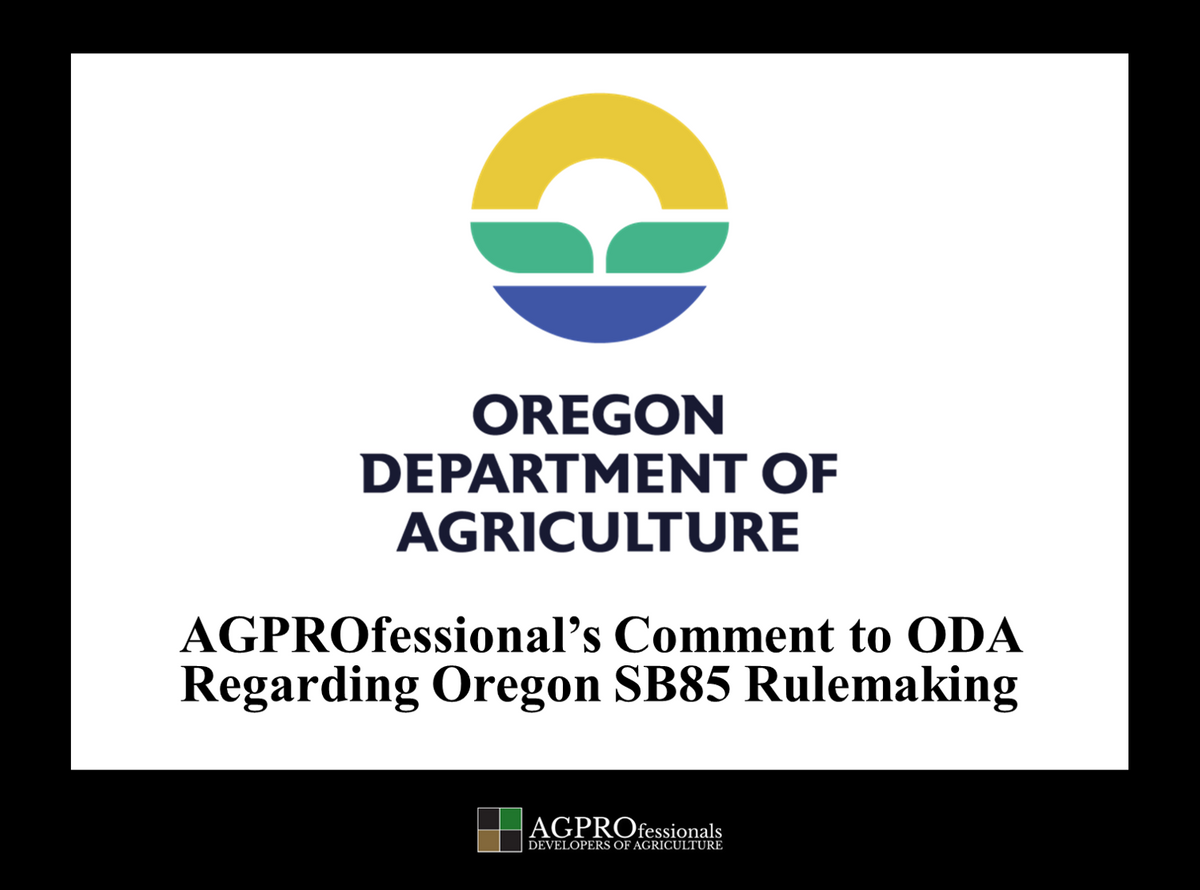Comments Regarding Proposed Oregon SB85 Rule Updates
At AGPROfessionals, our mission is to advocate for our clients. To this end, we follow the regulatory landscape and participate when necessary. Most recently, we stepped in on the Oregon Department of Agriculture’s request to comment on Oregon SB85 and proposed rule updates.
All too often, laws and regulations are passed without thought to the bigger picture and their ripple effect. In the case of Oregon SB85, we commented on:
- The practical application of definitions
- The Water Supply Plan
- Permit application procedures
- Facilities in the groundwater management area
- Concerns about limiting large modern farms and the increase in regulations, including practical and economic impacts
See our comment verbiage below, submitted on July 22nd.
***********************
Our experienced industry engineers at AGPROfessionals are writing in response to the SB 85 rulemaking process. We want to express our concerns and to provide feedback on the proposed rules updates impacting large modern farms (Confined Animal Feeding Operations (CAFO)). While we acknowledge the necessity of regulatory updates to ensure environmental protection and sustainable agricultural practices, there are several points regarding the proposed changes, particularly around the development, expansion, and increased regulation of large modem farms, that we feel are important to bring to your attention.
Definitions
The efforts to update and clarify definitions in the Proposed Rule Making are commendable. However, establishing a 100-gallon/day liquid wastewater generation minimum compared to the old definition is not practical. For example, if a l 0-gallon per minute garden hose is left on for 10 minutes, this could classify a facility as a CAFO. This change appears excessively stringent and presents challenges in terms of monitoring and enforcement.
Water Supply Plan
The Water Supply Plan (WSP), as required by SB 85, is designed to ensure that every farm has identified and documented all legal water sources. This plan allows the Oregon Water Resource Department (OWRD) to review whether these sources are authorized and sufficient for large farm operations. Including specific water estimates for cattle consumption in rulemaking is unnecessary since these figures are meant to guide calculations, not to be strict rules. This overreach reduces the incentive and ability for producers and professionals to explore and utilize new technologies, recycling methods, and other innovative practices in their water usage calculations. Additionally, the plan does not account for real conservation.
Permit Application Procedures
Clarifying the requirements for a complete permit application for a large modern farm, including new requirements like pre-application consultation, WSP, and neighbor notice, is helpful for operators and their consultants to know what is required for permitting.
Facilities Located in Ground Water Management Areas
Requiring new large farm applicants in a Ground Water Management Area (GWMA) to apply for an individual permit is not necessary. The GWMA shave been in place for approximately 35 years and though nitrate levels have changed over the years, the GWMA areas do not appear to have been adjusted. Facilities in the GWMAs should be required to follow all the requirements for large modern farms but should not have to go through additional regulatory requirements than those outside of the GWMA.
Concerns on Limiting Large Modern Farms and Increasing Regulations
We have concerns about the potential limitations on the development of large modern farms and the increase in regulations as well as their impact on providing affordable, nutritious food for Oregon citizens. The concerns can be broken down into two categories, practical implementation and economic:
- Practical Implementation: Practical implementation must be considered. When new regulations are punitive and not practical it imposes excessive financial and operational burdens on farm operators, especially smaller operations. If new regulations are not practical, or affordable to implement then it can create insurmountable barriers for smaller producers. These barriers translate to smaller producers going out of business and the consolidation of these smaller fam1s into larger operations.
- Economic Impact: Striking a balance between producing food, environmental protection and the economic viability of efficient large scale farming operations is crucial. Excessive regulations will have an economic impact on both the producer and the consumer. Higher costs will hinder the growth and sustainability of the agricultural sector and its ability to provide nutritious and affordable food for the citizens of the state of Oregon.
- In conclusion, while we acknowledge and support the intent of the proposed rule updates to enhance environmental protection and ensure sustainable agricultural practices, we urge the Oregon Department of Agriculture and the Oregon Department of Environmental Quality to consider the potential impacts on farm development and operations. We recommend a balanced approach that protects the environment while supporting the agricultural community's growth, sustainability, and ability to provide affordable, healthy, and nutritious food to the citizens of the state of Oregon.
- Letter found below

